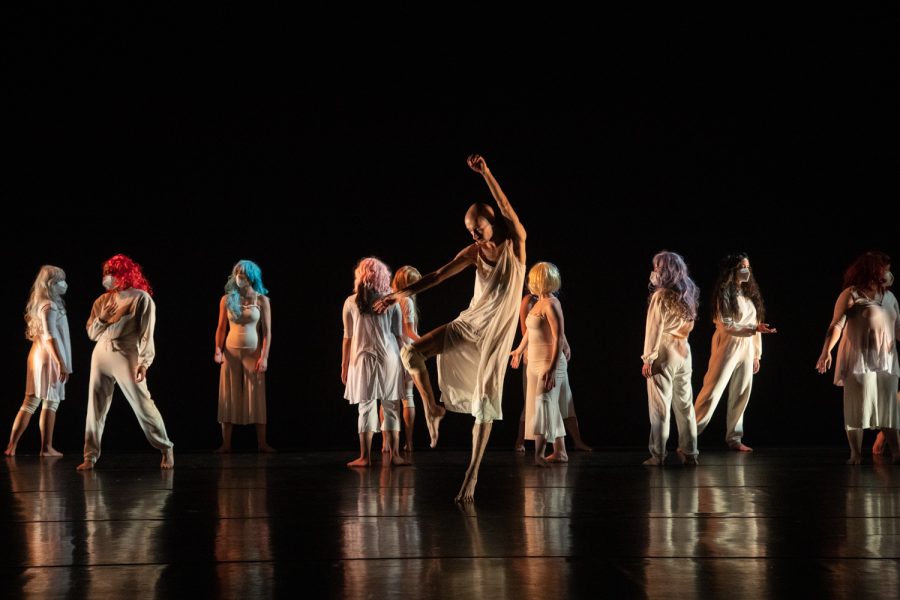Three-part UI Dance Thesis Concert to premiere at Space Place Theatre
Showcasing the thesis projects of MFA candidates Katie Phelan, Darrius Gray, and Sean Boyt, the University of Iowa Dance Thesis Concert showcases a variety of disciplines and inspirations expressed through dance.
Sean Thomas Boyt performs their dance thesis piece titled, “Seanshuuraka” in Space Place Theatre on Monday, April 11, 2022.
April 11, 2022
For over a year, three University of Iowa MFA candidates in the department of dance have been preparing for the culmination of their educational careers.
Katie Phelan, Darrius Gray, and Sean Boyt are the UI students who are presenting their thesis performances. Each routine is distinct from the others, with personal experiences and disciplines influencing the artists’ work for a three-part thesis concert, which will take place on April 13-15 at the Space Place Theater.
The first routine planned to be presented at the concert is titled Exposing Layers, choreographed by Phelan in collaboration with the other performers. Phelan said that the piece uses a combination of videography and live dancing layered over each other to question the impact that space has on performance.
Currently, Phelan is studying the intersection of film and dance and uses her previous experiences to execute her work. In the piece, some live dancers will perform on stage, but downstage holds a scrim, a large piece of partially transparent fabric, that projects the dancers digitally.
“I am relying on some history in my work professionally as a dancer and choreographer in live performance work, and then my current research as a graduate student in screen dance and merging these two realities together for a live performance work,” Phelan said.
The purpose of combining digital and live performance mediums is to heighten a focus on space, Phelan said. The complex idea of digital communication’s necessity for technology as a mediator has fascinated Phelan and has had a great influence on her work.
“It’s mediating the dancers on stage from physical space into the digital dimension,” Phelan said. “In the effect of layering the scrim in front or on top of the live body dancers, we’re looking at how these two dimensions can interact and have a relationship with each other. It’s not just a viewing of a live body and a digital body — it’s the viewing of their relationship together.”
The second routine on the itinerary is titled finis., choreographed by Gray. Starting as a gymnast when he was a child, Gray has gotten a vast array of experience in dance as he explored what the world of performing arts had to offer.
Gray’s work has a heightened focus on modern events. Social turmoil, war, and the COVID-19 pandemic are but a handful of topics that Gray was influenced by and addresses in his thesis performance.
“I started last year, investigating ways that the lived experience influenced how we perform as dancers,” Gray said. “As a dancer, we’re always given the opportunity to do certain roles within the ballets or even in modern pieces, and [I ask] ‘how does that lived experience influence how we move as dancers?’”
Utilizing these topical lived experiences, understanding the state of society is essential for his work. Gray said that currently, mentorship and genuine communication is not as common as it was when he was younger. Gray wanted to inspire the community with his work — he said that to an extent, the work that he conceived was driven by that goal.
“I felt like a lot of people don’t embrace that or acknowledge that anymore. It seems just like a system of corporate minds or institutional minds,” Gray said. “I think that’s why it’s important for me to bring back that sort of integrity of what our arts is about.”
RELATED: UI ‘Collaborative Performance’ expanded the creativity of students through partnership
The last performance listed for the concert is Seanshuuraku, choreographed by Boyt. Inspired by their name and the Japanese word that translates to ‘concluding performance,’ Boyt’s thesis project is directly inspired by personal experience and growth.
Boyt said that their work and common themes have been explored through much of their other choreographed performances. Taking the specific angle of a final project, Boyt said that this is a refinement of their previous work.
“As a thesis, this is the finale of my graduate career. This work is kind of riffing off a lot of the similar ideas I’ve been playing with in recent works, specifically dealing with trans-ness and nonbinary bodies,” Boyt said. “Also, in a very different vein, looking at Japanese idol culture and the pop stardom that some of us aspire to or look up to in a performative or very glamorized way.”
Full nudity is an element that Boyt was excited to include in their piece. Using nudity as a way of accepting one’s body and allowing oneself to be incredibly vulnerable in front of an audience, Boyt said the inclusion encapsulates the theme of Seanshuuraku as a whole.
“It’s admitting that one has a body and that’s something that one has to contend with, especially on stage,” Boyt said. “The performer’s body is in full view of their audience, whether they’re clothed or costumed, or whatnot. Literally stripping back these layers of sequins and tulle, the performer and also the audience is forced to contend with [the fact that] this person has a body.”
All three of the performers attested to the excitement that comes with performing to a live audience. While the arts were able to continue digitally while the COVID-19 pandemic was at its peak, artists are still excited to return to the stage and share their art in a living space.
“As someone that staked a lot of my career on solo improvisations [performances] are not quite the same on Zoom,” Boyt said. “They’re not interesting to me as a performer. They’re not interesting to me as a viewer.”



